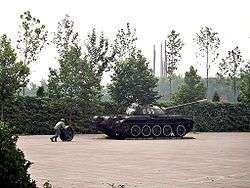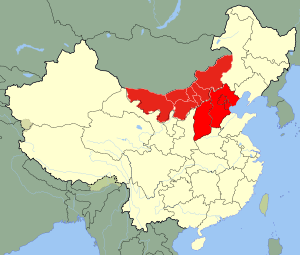Beijing Military Region
| Beijing Military Region | |||||||
|
Beijing Military Region (highlighted) | |||||||
| Simplified Chinese | 北京军区 | ||||||
|---|---|---|---|---|---|---|---|
| Traditional Chinese | 北京軍區 | ||||||
| |||||||
The Beijing Military Region was one of seven military regions for the Chinese People's Liberation Army. It has administration of all military affairs within Beijing city, Tianjin city, Hebei province, Shanxi province, and Inner Mongolia Autonomous Region. The Region is mainly responsible for defending the People's Republic of China from Mongolia and Russia, and also protects the capital of China, with the largest number of military personnel of any of the seven regions. This region is now superseded by Central Theater Command.
The International Institute for Strategic Studies attributes to the command of 300,000 personnel, consisting of three group armies (the 27th Army, 38th Army, and the 65th Army), two armoured divisions, one mechanised infantry division, five motorised divisions, one artillery division, three armoured, seven motorised infantry, four artillery, a total of five various anti-aircraft brigades, and one anti-tank regiment.[1] The command is also augmented by the Beijing Garrison, which consists of the 1st and 3rd Beijing Garrison Divisions (Police), and the Beijing Garrison Honor Guard Battalion and Color Guard Company, both of them are charged with public duties, and is also home to the PLA Navy (PLAN) North Sea Fleet and the PLA Air Force (PLAAF) 10th Air Force Corps.
In reductions announced in September 2003, the 24th Group Army (Hebei), and the 63rd Group Army (Shanxi) were both disbanded. Over the course of the 2003 reductions cycle, Dennis Blasko estimates that the 114th Mechanised Infantry Division of the 38th Group Army, the 70th Division of the 24th Group Army, two artillery brigades, and an anti-aircraft artillery brigade appear to have been dropped from the force. [2]
The last commander was General Song Puxuan (2014-2016). The political commissar was General Liu Fulian.
History and mission

The Beijing Military Region traces its lineage to the establishment of the Northwest Military Region in May 1948. It was renamed the Beijing Military Region in 1955,[3] when the Inner Mongolia Military Region was downgraded to a district, and was folded into the Beijing Military Region.
The Beijing Military Region is primarily charged with protecting the capital. Because of its location in the capital, the Beijing Military Region is the most important of the seven military regions. Each unit from the Beijing Military Region contributed forces to Beijing for the crackdown on the Tiananmen Square protests of 1989, and these elements remained deployed in Beijing long after using deadly force to remove the demonstrators.[4]
In addition to guarding the capital, the Beijing Military Region is also in charge of training key personnel for leadership positions through the numerous military academies in the region.
Nickname
Organizations affiliated with the Beijing Military Region often use the nickname "comrade" (Chinese: 战友; pinyin: zhànyǒu; literally: "battle friend"), including the Comrade Performance Troupe (Chinese: 战友文工团) and the Comrade Newspaper (Chinese: 战友报).
References
- ↑ International Institute for Strategic Studies, The Military Balance 2006
- ↑ Dennis Blasko, The Chinese Army Today: Tradition and Transformation, 2006, 77
- ↑ Li, Gucheng (1995). A Glossary of Political Terms of the People's Republic of China. Chinese University Press. p. 534. ISBN 9789622016156.
- ↑ GlobalSecurity.org - Beijing Military Region, Beijing Military Area Command

